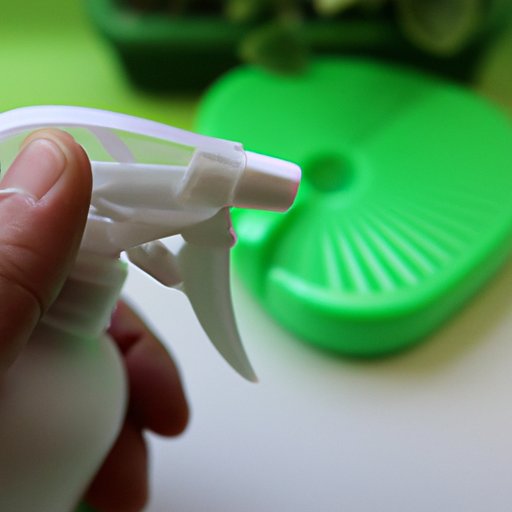
Introduction
Fleas are tiny blood-sucking insects that can infest homes and cause irritation, discomfort, and health problems for humans and pets. They reproduce quickly and are hard to spot, making flea control a challenging task for homeowners. However, with the right tools and knowledge, you can get rid of fleas and prevent their return. In this article, we will explore some of the best DIY solutions and professional tips for dealing with fleas effectively.
DIY Flea Traps
Flea traps are a simple and effective way to monitor and reduce the flea population in your home. You can easily make your own flea traps using household items such as dish soap, warm water, and a light source. To do so:
- Fill a shallow dish with warm water and add a few drops of dish soap.
- Place the dish on the floor near a night light or desk lamp.
- Leave the trap overnight or for a few days.
- Check the trap regularly for any trapped fleas.
- Dispose of the water and fleas by flushing them down the toilet or sealing the dish in a plastic bag and throwing it away.
You can also use flea traps for outdoor areas by placing them in shady, moist, and warm spots where fleas tend to thrive, such as under bushes, near pet beds, or in crawl spaces.
Essential Oils
Essential oils are a natural and fragrant way to repel and kill fleas. Some of the most effective essential oils for flea control include:
- Lavender oil, which has a calming and soothing effect on pets and humans.
- Tea tree oil, which has antibacterial and antifungal properties and can repel fleas, ticks, and mosquitoes.
- Peppermint oil, which has a cooling and refreshing effect on the skin and can deter fleas, ants, and spiders.
To use essential oils for flea control:
- Add a few drops of one or a combination of these oils to a spray bottle filled with water and shake well.
- Spray the solution on your pet’s bed, carpet, furniture, and any other flea-infested areas.
- Repeat the application every few days or as needed.
- Avoid spraying the solution on your pet’s skin or eyes, and test a small area first to check for any allergic reactions.
Vacuuming
Regular vacuuming is a crucial part of flea control as it can remove fleas, their eggs, and their food sources from your home. Vacuuming is particularly effective on carpets, rugs, floors, and upholstered furniture. To vacuum your home for fleas:
- Use a vacuum with high suction power and a beater bar or brush attachment.
- Start by vacuuming the areas where your pet spends most of its time, such as the sleeping areas, feeding areas, and play areas.
- Be thorough and go over the same areas multiple times from different angles.
- Dispose of the vacuum bag or canister contents immediately in an outdoor trash bin or seal them in a plastic bag and throw them away.
- Repeat the process regularly, at least once a week.
Professional Extermination Services
If your flea infestation is severe or persistent, you may need to hire a professional exterminator to help you eliminate the problem. Professional flea exterminators use safe and effective methods to treat your home and pets for fleas, such as:
- Applying insecticides and growth regulators to infested areas and surfaces.
- Using heat treatments or fumigation to kill fleas and their eggs.
- Treating your pets with flea medication or a flea bath.
The cost of professional flea extermination can vary depending on the size of your home and the severity of the infestation. Generally, you can expect to pay anywhere from $100 to $500 for a one-time treatment or $300 to $1200 for a yearly contract.
Flea-Repelling Plants
Some plants have natural flea-repelling properties and can be a useful addition to your garden or indoor spaces. Some of the best flea-repelling plants include:
- Rosemary, which has a strong scent that can repel fleas, ticks, and other pests.
- Basil, which can deter fleas and mosquitoes and has medicinal and culinary uses.
- Catnip, which can attract cats while repelling fleas and other insects.
To use flea-repelling plants:
- Grow them in pots or in the garden near entrances, windows, and outdoor seating areas.
- Crush or rub the leaves to release their fragrance and deter fleas.
- Use the leaves as natural insect repellents for yourself and your pets.
Natural Flea Sprays
Natural flea sprays are an eco-friendly and safe alternative to chemical sprays. They can be made from common household ingredients such as vinegar, lemon juice, or salt. To make a natural flea spray:
- Fill a spray bottle with water and add 1-2 cups of vinegar or 1-2 tablespoons of lemon juice or salt.
- Shake well and spray the solution on your pet’s coat, bed, and other flea-infested areas.
- Avoid spraying the solution on any open wounds or sensitive areas.
- Repeat the application every few days or as needed.
Remember to consult your vet before using any flea control products on your pets, as some solutions may not be suitable for all animals.
Conclusion
Dealing with flea infestations can be frustrating and overwhelming, but with these DIY solutions and professional tips, you can get rid of fleas and keep them away. Remember to use flea traps, essential oils, vacuuming, and natural flea sprays to control the flea population and prevent their return. Additionally, consider hiring a professional flea exterminator or growing flea-repelling plants for extra protection. By taking action and implementing these strategies, you can enjoy a flea-free home and a happier and healthier life for you and your pets.





